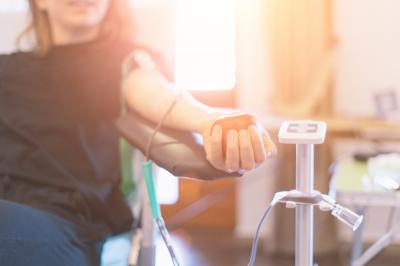Making a Pass at Passive Immunity
Research flirts with convalescent plasma as COVID-19 treatment
Been there, done that? Blood banks are seeking men and women of experience in hopes of getting the goods — namely, their SARS-CoV-2 targeting antibodies.
Convalescent plasma is a translucent liquid that is extracted from the blood of individuals recently recovered from infection — in this case COVID-19 — containing the antibodies that were used to ultimately fight the virus off. This material is transfused into currently infected individuals in hopes of lessening the duration or severity of their illness. Ideally, the strategy grants the recipient passive immunity to a disease — temporary protection for as long as the foreign antibodies are retained.
This is not to be confused with active immunity, wherein the body generates its own antibodies in response to antigens (harmful substances). Active immunity can only be stimulated by vaccines or previous exposure —this happens when the body is able to recall the antigen from its immunological memory. If passive immunity is sitting back while a technician fixes a household utility for you, activity immunity is the ability to diagnose and repair it yourself ("I've seen this before.")
When the COVID-19 pandemic intensified in March, the FDA approved the provisional use of convalescent plasma by individual physicians as an emergency investigational drug (eIND) process to treat seriously or critically ill patients. Early research seems to indicate that it is most effective when administered to individuals before intubation or life support becomes necessary. Its overall contribution in recoveries is not exactly crystal clear, however, because most patients who receive the transfusion do so in tandem with another form of therapy. Despite not having a firm answer about how much it helps, it almost certainly hasn't hurt — a major incident or complication has yet to be recorded.
As such, convalescent plasma has gained widespread support as a valid interim approach to COVID-19 treatment. It is also a subject of much interest in laboratory settings. By analyzing antibody protein structures, scientists hope to develop what's known as a hyperimmune globulin (or immune serum) for COVID-19 — basically a concentrated "antibody cocktail" tailored to a specific disease. Over the past century, they've successfully provided passive immunity against diseases such as diphtheria, tetanus, rabies, measles, polio, and varicella zoster (chickenpox). Hyperimmune globulins offer more reliable results and can be produced to scale.
In the meantime (or before the laboratories start calling), healthy COVID-19 survivors who:
- Are at least 17 years of age
- Weigh more than 110 pounds
- Had a verifiable COVID-19 diagnosis and have been symptom-free for at least two weeks
Can donate their convalescent plasma to the Community Blood Bank of Northwestern Pennsylvania and Western New York, who will distribute the units through the LECOM Health system. Until a COVID-19 vaccine is approved, be an active partner for passive immunity.
For more information or to begin the donation process, eligible candidates can contact Monica Murrillo, M.D. at 814-868-2179
Matt Swanseger is not qualified (or worthy) to draw your blood, but can be reached at mswanseger@eriereader.com regardless.


.png)
